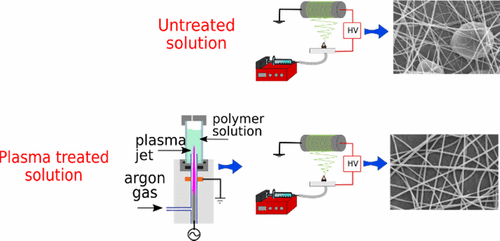当前位置:
X-MOL 学术
›
ACS Appl. Mater. Interfaces
›
论文详情
Our official English website, www.x-mol.net, welcomes your feedback! (Note: you will need to create a separate account there.)
Atmospheric Pressure Plasma Jet Treatment of Poly-ε-caprolactone Polymer Solutions To Improve Electrospinning
ACS Applied Materials & Interfaces ( IF 9.5 ) Pub Date : 2017-09-18 00:00:00 , DOI: 10.1021/acsami.7b08439 Silvia Grande 1 , Joachim Van Guyse 2 , Anton Y. Nikiforov 1 , Iuliia Onyshchenko 1 , Mahtab Asadian 1 , Rino Morent 1 , Richard Hoogenboom 2 , Nathalie De Geyter 1
ACS Applied Materials & Interfaces ( IF 9.5 ) Pub Date : 2017-09-18 00:00:00 , DOI: 10.1021/acsami.7b08439 Silvia Grande 1 , Joachim Van Guyse 2 , Anton Y. Nikiforov 1 , Iuliia Onyshchenko 1 , Mahtab Asadian 1 , Rino Morent 1 , Richard Hoogenboom 2 , Nathalie De Geyter 1
Affiliation

|
An atmospheric pressure plasma jet (APPJ) specifically designed for liquid treatment has been used in this work to improve the electrospinnability of a 5 w/v % solution of poly-ε-caprolactone (PCL) in a mixture of chloroform and N,N-dimethylformamide. Untreated PCL solutions were found to result in nonuniform fibers containing a large number of beads, whereas plasma-treated solutions (exposure time of 2–5 min) enabled the generation of beadless, uniform nanofibers with an average diameter of 450 nm. This enhanced electrospinnability was found to be mainly due to the highly increased conductivity of the plasma-modified PCL solutions. Consequently, more stretching of the polymer jet occurred during electrospinning, leading to the generation of bead-free fibers. Plasma treatment also results in an increased viscosity and decreased pH values. To explain these observed changes, optical emission spectroscopy (OES) has been used to examine the excited species present in the APPJ in contact with the PCL solution. This study revealed that the peaks attributed to H, CH, CH2, and C2 species could be responsible for the degradation of solvent molecules and/or PCL structures during the plasma treatment. Size exclusion chromatography and X-ray photoelectron spectroscopy results showed that the molecular weight and the chemical composition of PCL were not significantly affected by the APPJ treatment. Plasma exposure mainly results in the degradation of the solvent molecules instead of modifying the PCL macromolecules, preserving the original polymer as much as possible. A hypothesis for the observed macroscopic changes in viscosity and pH values could be the generation of new chemical species such as HCl and/or HNO3. These species are characterized by their high conductivity, low pH values, and strong polarity and could enhance the solvent quality for PCL, leading to the expansion of the polymer coil, which could in turn explain the observed enhanced viscosity after plasma modification.
中文翻译:

大气压等离子体射流处理聚ε-己内酯聚合物溶液以改善静电纺丝
在这项工作中,使用了专门设计用于液体处理的大气压等离子体射流(APPJ),以改善5-w / v%的聚ε-己内酯(PCL)在氯仿和N,N的混合物中的溶液的电纺丝性。-二甲基甲酰胺。发现未经处理的PCL溶液会导致含有大量珠粒的不均匀纤维,而经过等离子体处理的溶液(曝光时间为2–5分钟)能够生成平均直径为450 nm的无珠,均匀的纳米纤维。发现增强的电纺丝性主要是由于等离子体改性的PCL溶液的电导率大大提高。因此,在静电纺丝过程中发生了更多的聚合物射流拉伸,从而导致了无珠纤维的产生。等离子体处理还导致粘度增加和pH值降低。为了解释这些观察到的变化,已使用光发射光谱法(OES)来检查与PCL溶液接触的APPJ中存在的激发物种。这项研究表明,峰归因于H,CH,CH2和C 2物种可能是造成等离子体处理过程中溶剂分子和/或PCL结构退化的原因。尺寸排阻色谱和X射线光电子能谱分析结果表明,APPJ处理对PCL的分子量和化学组成没有明显影响。等离子体暴露主要导致溶剂分子降解,而不是修饰PCL大分子,从而尽可能保留原始聚合物。观察到的粘度和pH值宏观变化的假设可能是产生了新的化学物种,例如HCl和/或HNO 3。这些物质的特点是它们的高电导率,低pH值和强极性,可以增强PCL的溶剂质量,导致聚合物线圈膨胀,这又可以解释观察到的等离子体改性后粘度的增加。
更新日期:2017-09-18
中文翻译:

大气压等离子体射流处理聚ε-己内酯聚合物溶液以改善静电纺丝
在这项工作中,使用了专门设计用于液体处理的大气压等离子体射流(APPJ),以改善5-w / v%的聚ε-己内酯(PCL)在氯仿和N,N的混合物中的溶液的电纺丝性。-二甲基甲酰胺。发现未经处理的PCL溶液会导致含有大量珠粒的不均匀纤维,而经过等离子体处理的溶液(曝光时间为2–5分钟)能够生成平均直径为450 nm的无珠,均匀的纳米纤维。发现增强的电纺丝性主要是由于等离子体改性的PCL溶液的电导率大大提高。因此,在静电纺丝过程中发生了更多的聚合物射流拉伸,从而导致了无珠纤维的产生。等离子体处理还导致粘度增加和pH值降低。为了解释这些观察到的变化,已使用光发射光谱法(OES)来检查与PCL溶液接触的APPJ中存在的激发物种。这项研究表明,峰归因于H,CH,CH2和C 2物种可能是造成等离子体处理过程中溶剂分子和/或PCL结构退化的原因。尺寸排阻色谱和X射线光电子能谱分析结果表明,APPJ处理对PCL的分子量和化学组成没有明显影响。等离子体暴露主要导致溶剂分子降解,而不是修饰PCL大分子,从而尽可能保留原始聚合物。观察到的粘度和pH值宏观变化的假设可能是产生了新的化学物种,例如HCl和/或HNO 3。这些物质的特点是它们的高电导率,低pH值和强极性,可以增强PCL的溶剂质量,导致聚合物线圈膨胀,这又可以解释观察到的等离子体改性后粘度的增加。


























 京公网安备 11010802027423号
京公网安备 11010802027423号